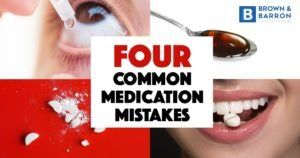Every year, the U.S. Food and Drug Administration (FDA) receives more than 100,000 reports of suspected medication errors. A lot can go wrong between the time a medication is chosen until the time that it enters the body. From the terrible handwriting of the doctor to the way-too-busy nurse to the inexperienced new pharmacy employee, there is a lot of opportunity for human error. Of course, those of us taking the medications are human, too, and patient error accounts for a significant portion of medication errors.
The world-famous Mayo Clinic reported four common mistakes people make that lead to medication errors…
1.) Confusing eardrops and eyedrops.
It’s common for us to see something familiar and skip the directions. So, it is not hard to imagine someone mistaking eardrops for eyedrops and vice versa. Always check the label. The Mayo Clinic adds this helpful tip: “If a medication says ‘otic,’ it’s for the ears. If it says ‘ophthalmic,’ it’s for the eyes.”
2.) Chewing non-chewables.
Some people have trouble swallowing pills, so they figure, “Why not chew them up?” It might seem like there’s no difference, but that is a bad assumption. Some pills are time-released, and by chewing them you can get a massive dose at once, called “dose dumping,” which can potentially lead to overdose or other dangerous side effects.
3.) Cutting up pills.
Unless instructed by your doctor or pharmacist, you should never split your pills. Some have coatings designed to release the medication over time or to protect the stomach. Some are liquid filled capsules, making splitting a messy and ill-advised decision. Some pills are too small or unusually shaped, making a perfect split too difficult. If directed, use a specialized pill-splitting tool after consulting your doctor or pharmacist.
4.) Using the wrong spoon.
Don’t try to use the dinner spoons in your silverware drawer. Even your cooking spoons are probably a bad idea. To get an accurate dose, the Mayo Clinic recommends using an oral syringe or the dose cup. They usually come with the medication, but ask your pharmacist if neither has been included. The syringe and dose cup are transparent with easy-to-read markings to help you measure the exact dosage.
The Role of the Pharmacist & Pharmaceutical Malpractice
These types of medication errors often happen because the pharmacy is failing to provide patient education and guidance on their medications. Your pharmacist has a duty to counsel the patient on the usage and effects of the medication, including the effects of long-term usage, and to provide any important warnings and medicine-related instructions when dispensing medications to you or for your loved ones. In some cases, the pharmacy fails to include any instructions, which can lead to a risk of medication errors with dire consequences. It can prolong an existing health situation or make it worse. This is referred to as pharmaceutical malpractice. There are even more extreme examples of pharmaceutical malpractice, in which the pharmacy provides incorrect instructions (e.g., the wrong dosage instructions), the wrong strength of the medication, the wrong medication altogether, or defective medications. These can lead to catastrophic injuries or even death. The pharmacy also has a duty to confirm a prescription with the prescribing health professional if there is an obvious error. A lack of patient education and errors due to negligence at the pharmacy contribute to the serious problem of medication errors.
According to the National Coordinating Council for Medication Error Reporting and Prevention (NCCMERP), a medication error is “any preventable event that may cause or lead to inappropriate medication use or patient harm while the medication is in the control of the health care professional, patient, or consumer.” According to the Journal of Community Hospital Internal Medicine Perspectives, more than 7 million patients in the U.S. are impacted by medication errors every year.
When Medication Errors Result from Medical Malpractice
Every year, 7,000 to 9,000 people die because of a medication error in the United States. At Brown & Barron, we have extensive expertise and experience dealing with hospitals nursing homes, and other medical facilities to determine the cause of a patient’s medical error. Like all other forms of medical malpractice claims, you need an expert who can investigate whether the established standard of care was followed, build the evidence to prove it, and get the appropriate financial recovery. Brown & Barron will work with you and experts in the medical field to determine where the negligence lies, and together we can hold those responsible accountable for their errors. If you suspect medical malpractice, trust those instincts and get answers from Brown & Barron with a free consultation at (410) 698-1717 or online by clicking here.


